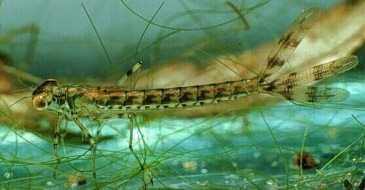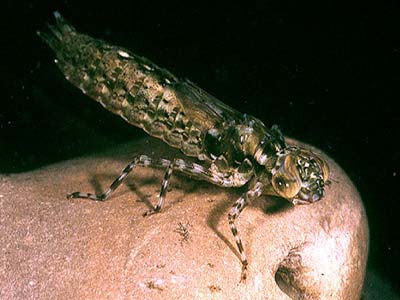All odonate larvae possess a labial mask. Other obvious features include a large head with well-developed eyes, external wingpads in the later stages, and either a narrowly tapering, or fusiform, or rounded abdomen. Gills occur along the sides of the abdomen in one zygopteran family and gill protrusions in other places (eg, on the terminal segments) in a few tropical genera. However, the vast majority of aquatic insect larvae with abdominal lateral gills or gill tufts are mayflies (Ephemeroptera) or stoneflies (Plecoptera).


Young larva of a damselfly, Austrolestes colensonis (New
Zealand). Photo: R. J. Rowe
Copyright © 1997 R. J. Rowe


Near-mature larva of an aeshnid dragonfly (USA). Photo:
Larry J. Friesen
Copyright © 1997 Larry Jon Friesen, Santa Barbara
City College, USA.
Identification to suborder can be based on the caudal end of the body. Zygopterans have three (very exceptionally two) plate-like, cylindrical or sac-like gills. Although these sometimes are broken or lost, rarely are all three missing and invariably the stumps can be seen. In Anisoptera and Anisozygoptera these gills are reduced to three short spines, forming with two others a pointed "anal pyramid" around the rectum. Gas exchange in Anisopteran larvae is by gills inside the rectum. Many Anisoptera use 'jet propulsion' -- forcible expulsion of water from the rectum -- as an escape response.



 Go to quick links
Go to quick search
Go to navigation for this section of the ToL site
Go to detailed links for the ToL site
Go to quick links
Go to quick search
Go to navigation for this section of the ToL site
Go to detailed links for the ToL site